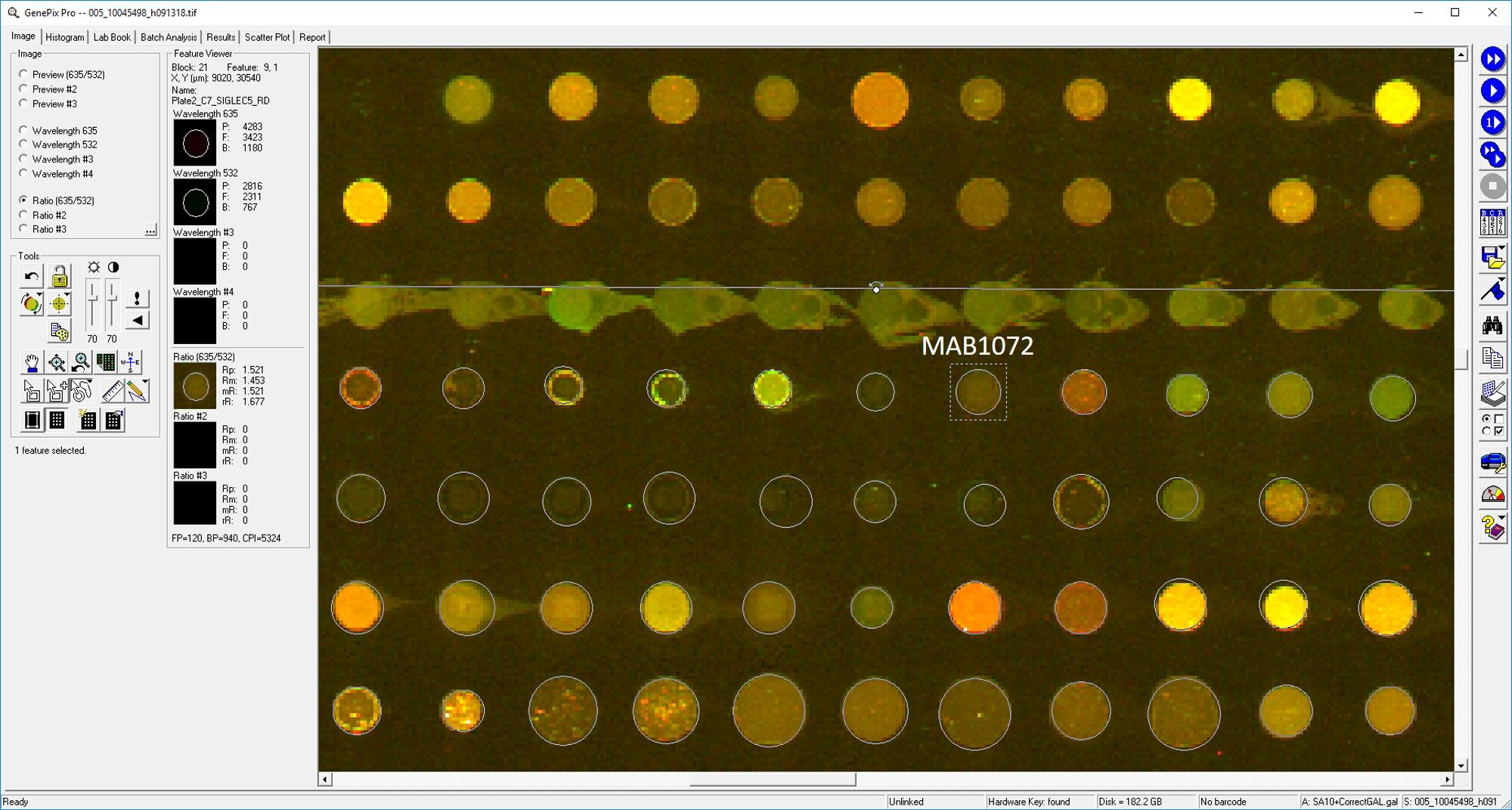Human Siglec-5/CD170 Antibody Summary
Lys18-Thr434
Accession # O15389
Applications
Please Note: Optimal dilutions should be determined by each laboratory for each application. General Protocols are available in the Technical Information section on our website.
Reconstitution Calculator
Preparation and Storage
- 12 months from date of receipt, -20 to -70 °C as supplied.
- 1 month, 2 to 8 °C under sterile conditions after reconstitution.
- 6 months, -20 to -70 °C under sterile conditions after reconstitution.
Background: Siglec-5/CD170
Siglecs (1) (sialic acid binding Ig-like lectins) are I-type (Ig-type) lectins (2) belonging to the Ig superfamily. They are characterized by an N-terminal Ig-like V-type domain which mediates sialic acid binding (3), followed by varying numbers of Ig-like C2-type domains (1, 4). Eleven human Siglecs have been cloned and characterized (1, 4). They are sialoadhesin/CD169/Siglec-1, CD22/Siglec-2, CD33/Siglec-3, Myelin-Associated Glycoprotein (MAG/Siglec-4a) and the Siglec-5 to 11 (4, 5, 7). To date, no Siglec has been shown to recognized any cell surface ligand other than sialic acids, suggesting that interactions with glycans containing this carbohydrate are important in mediating the biological functions of Siglecs. Siglec-5 to 11 share a high degree of sequence similarity with CD33/Siglec-3 both in their extracellular and intracellular regions. They are collectively referred to as CD33-related Siglecs. One remarkable feature of the CD33-related Siglecs is their differential expression pattern within the hematopoietic system (4, 5). This fact, together with the presence of two conserved immunoreceptor tyrosine-based inhibition motifs (ITIMs) in their cytoplasma tails, suggests that CD33-related Siglecs are involved in the regulation of cellular activation within the immune system. Human Siglec-5 cDNA encodes a 551 amino acid (aa) polypeptide with a hydrophobic signal peptide, an N-terminal Ig-like V-type domain, three Ig-like C2-type domains, a transmembrane region and a cytoplasma tail (6). Siglec-5 exists as a disulfide-linked homodimer on the cell surface and is expressed on monocytes, neutrophils and B cells (4, 5, 6). It binds equally well to both alpha 2,3- and alpha 2,6-linked sialic acid (6).
- Crocker, P.R. et al. (1998) Glycobiology 8:v.
- Powell, L.D. et al. (1995) J. Biol. Chem. 270:14243.
- May, A.R. et al. (1998) Mol. Cell 1998. 1:719.
- Crocker, P.R. and A. Varki (2001) Trends Immunol. 22:337.
- Crocker, P.R. et al. (2001) Immunology 103:137.
- Cornish, A.L. et al. (1998) Blood 92:2123.
- Angata, T. et al. (2002) J. Biol Chem. 277:24466.
Product Datasheets
Citations for Human Siglec-5/CD170 Antibody
R&D Systems personnel manually curate a database that contains references using R&D Systems products. The data collected includes not only links to publications in PubMed, but also provides information about sample types, species, and experimental conditions.
5
Citations: Showing 1 - 5
Filter your results:
Filter by:
-
Essential role of TOSO/FAIM3 in intestinal IgM reverse transcytosis
Authors: N Rochereau, E Michaud, L Waeckel, M Killian, R Gayet, R Goguyer-De, X Roblin, G Biolley, B Corthésy, S Paul
Cell Reports, 2021-11-16;37(7):110006.
Species: Human
Sample Types: Whole Cells
Applications: Neutralization -
Siglec expression on the surface of human, bull and ram sperm
Authors: K Alkhodair, H Almhanna, J McGetrick, S Gedair, ME Gallagher, B Fernandez-, T Tharmaling, PB Larsen, E Fitzpatric, P Lonergan, ACO Evans, SD Carrington, CJ Reid
Reproduction, 2018-04-01;155(4):361-371.
Species: Bovine, Human, Ovine
Sample Types: Tissue Homogenates, Whole Cells
Applications: IHC, Western Blot -
Siglec-5 and Siglec-14 are polymorphic paired receptors that modulate neutrophil and amnion signaling responses to group B Streptococcus.
Authors: Ali S, Fong J, Carlin A, Busch T, Linden R, Angata T, Areschoug T, Parast M, Varki N, Murray J, Nizet V, Varki A
J Exp Med, 2014-05-05;211(6):1231-42.
Species: Human
Sample Types: Cell Lysates
Applications: Western Blot -
Human Siglec-5 inhibitory receptor and immunoglobulin A (IgA) have separate binding sites in streptococcal beta protein.
Authors: Nordstrom T, Movert E, Olin AI, Ali SR, Nizet V, Varki A, Areschoug T
J. Biol. Chem., 2011-07-27;286(39):33981-91.
Species: Human
Sample Types: Recombinant Protein
Applications: Western Blot -
Discovery of Siglec-14, a novel sialic acid receptor undergoing concerted evolution with Siglec-5 in primates.
Authors: Angata T, Hayakawa T, Yamanaka M, Varki A, Nakamura M
FASEB J., 2006-10-01;20(12):1964-73.
Species: Human
Sample Types: Whole Cells
Applications: ICC
FAQs
No product specific FAQs exist for this product, however you may
View all Antibody FAQsReviews for Human Siglec-5/CD170 Antibody
Average Rating: 4 (Based on 4 Reviews)
Have you used Human Siglec-5/CD170 Antibody?
Submit a review and receive an Amazon gift card.
$25/€18/£15/$25CAN/¥75 Yuan/¥2500 Yen for a review with an image
$10/€7/£6/$10 CAD/¥70 Yuan/¥1110 Yen for a review without an image
Filter by:



